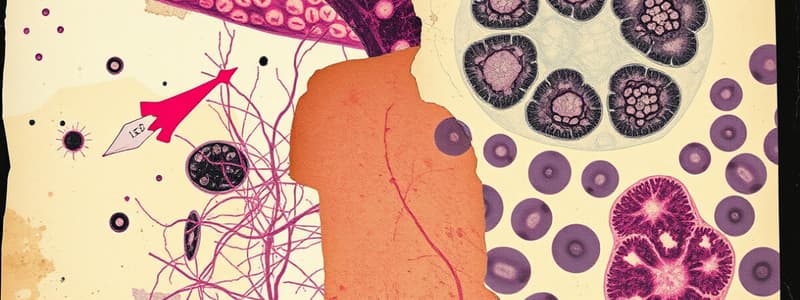Podcast
Questions and Answers
What is histology?
What is histology?
The study of the tissues of the body and how these tissues are arranged to constitute organs.
Tissues only consist of cells.
Tissues only consist of cells.
False (B)
What are the two interacting components of tissues?
What are the two interacting components of tissues?
Cells and Extracellular Matrix (ECM).
Bacteria are eukaryotic cells.
Bacteria are eukaryotic cells.
Which of the following are components of the extracellular matrix in humans? (Select all that apply)
Which of the following are components of the extracellular matrix in humans? (Select all that apply)
Who is considered the father of modern histology?
Who is considered the father of modern histology?
The first step in tissue preparation is ______.
The first step in tissue preparation is ______.
Match the following steps in tissue preparation with their corresponding actions:
Match the following steps in tissue preparation with their corresponding actions:
Flashcards are hidden until you start studying
Study Notes
What is Histology?
- Study of body tissues and their organization into organs.
- Focuses on cellular structure and arrangement to optimize specific organ functions.
- Derived from the term "histo," meaning tissue or web.
Brief Background on Tissues
- Tissues consist of two components:
- Cells: Basic structural and functional units of the body, eukaryotic in animals, producing the extracellular matrix (ECM).
- Extracellular Matrix (ECM): Non-cellular component providing structural support, hydration, and selective barriers.
Cells
- Eukaryotic cells have membrane-limited organelles within the cytoplasm.
- Prokaryotic cells (like bacteria) have a cell wall surrounding a simple plasmolemma with no membrane-bound organelles.
Extracellular Matrix (ECM)
- Provides physical scaffolding for cells and maintains hydration.
- Composed of:
- Fibrous elements: Collagen, elastin, reticulin.
- Link proteins: Fibronectin, laminin.
- Space-filling molecules: Proteoglycans, glycosaminoglycans.
- Functions include nutrient transport, cellular support, and waste removal.
Contributions of Marie François Xavier Bichat
- Considered the father of modern histology and descriptive anatomy.
- First to study and define tissues anatomically, introducing the term "tissue."
- Identified different textures and weaves in the body, describing them as layers.
Preparation of Tissues for Study
- Key steps for histological tissue preparation include:
- Fixation
- Decalcification (optional)
- Dehydration
- Clearing
- Impregnation (Infiltration)
- Embedding
- Trimming
- Section-Cutting (Microtomy)
- Staining
- Mounting
- Labeling
Importance of Fixation
- Crucial first step in the preparation process to preserve tissue structure for analysis.
Studying That Suits You
Use AI to generate personalized quizzes and flashcards to suit your learning preferences.




